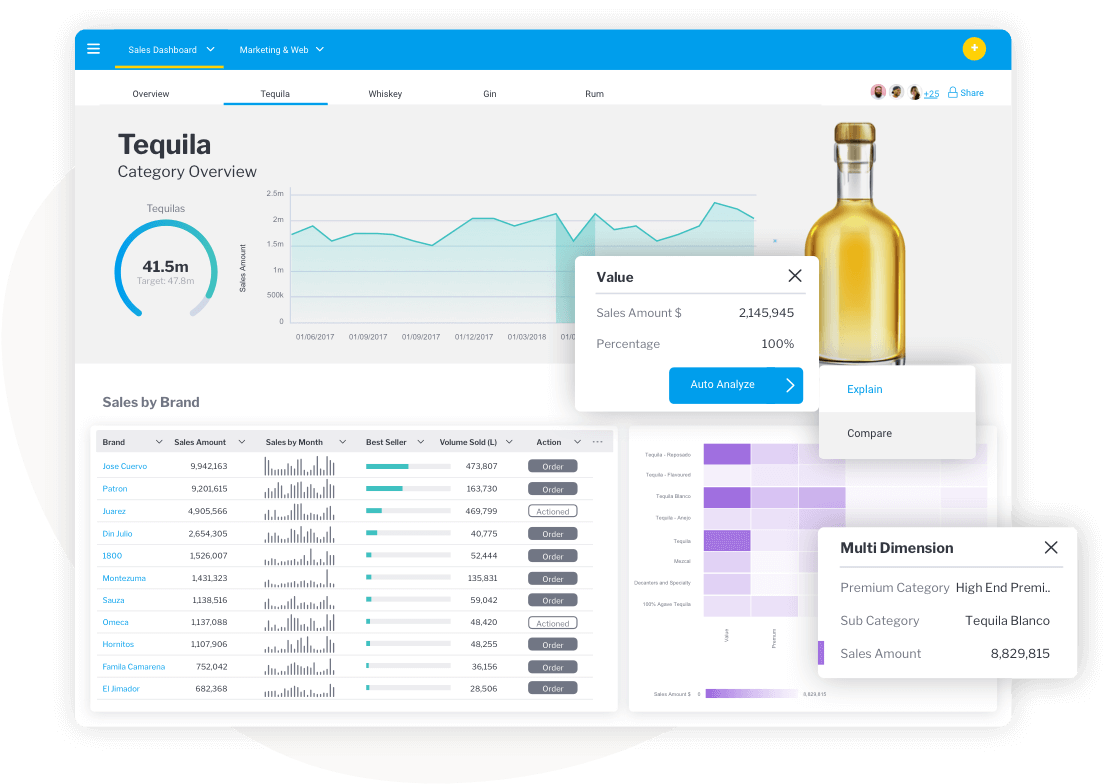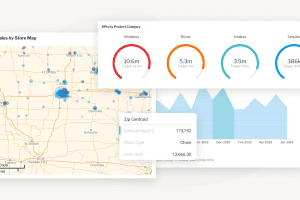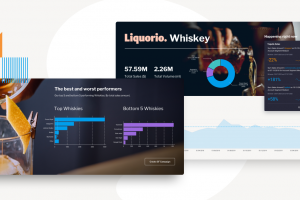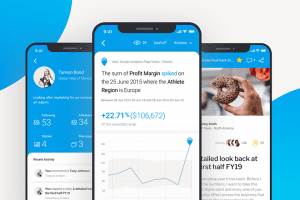
8 Business Benefits of BI Dashboards
Business intelligence (BI) dashboards, also known as BI dashboards, are a powerful way to help people collect, share and analyze their business data to make informed decisions.
Business dashboard software can help users monitor operations, optimize processes, and improve overall business performance by having data readily available, and can also help detect and prevent potential problems before they become issues with its use of real time data.
With all the benefits of BI dashboards, it's no wonder so many businesses are investing in analytics solutions today. Here are 8 of the most common benefits of BI dashboards.
BI dashboards: A refresher
Business intelligence dashboards aggregate and display data in a visualized overview that can be used to analyze and improve performance. They can be used to track and monitor key business metrics, such as sales, customer churn, and employee productivity.
Business users, such as sales managers, can leverage BI dashboards to quickly and easily see trends and correlations in data. This can help many people across the organization have easier access to critical data, make better decisions and improve performance.
The proliferation of self service BI solutions in the past decade has opened up the availability of dashboards to regular, non-technical business people, and made it an essential tool to help them discover insights from real-time metrics, and inform their decision-making. But there's more benefits to using dashboards than just this.
Related: 4 Key Features of a Modern BI Dashboard
What are 8 business benefits of BI dashboards?
A dashboard brings a number of key advantages for organizations when used correctly, such as the ability to monitor, visualize and take faster, informed action on real-time metrics. We break down the top 8 benefits in the section below.
1. Communicating business critical information at-a-glance
Data sources can provide valuable insights into your business operations, but it can be difficult to understand and analyze the data in a timely manner. BI dashboards can help you quickly and easily access critical information you need to make informed decisions.
A BI dashboard additionally allows for visualization of data in a way that makes information easy to understand, and allows for quick comparison of different aspects of your business. Data visualizations such as charts and graphs can help you identify trends and patterns that may otherwise be difficult to see when viewing raw data (tables or numbers) alone.
Trends, sales data, and customer information can all be easily monitored and analyzed using BI dashboards, too, helping you make better decisions and improve your operations.
2. Tracking and executing on KPIs
Key performance indicators (KPIs) are important tools that can help you track the progress of your business. BI dashboards can help you easily view and analyze data related to your KPI goals, and many organizations today specifically create KPI dashboards for that reason.
KPIs help you identify areas where your business is performing well and identify areas where you need to improve. Having this information available at a glance in a well organized dashboard can help you make informed decisions and better manage your resources.
Having KPIs updated in real-time on a KPI dashboard can also be used to measure the effectiveness of your marketing and sales efforts, without the typical constant need to refresh reports.
3. Empowering users with better accessibility to information
BI dashboards let users to get a better understanding of the business data by making it easier for them to find and access information.
Real time data visualizations help users see patterns and trends that they may not have been able to see before. This can help employees make better decisions and improve the efficiency of their work.
Users can also use BI dashboards to monitor their own performance and track changes over time. This can help businesses to identify areas of improvement and make necessary changes.
4. Achieving true data-driven decision-making
A BI dashboard can help you quickly and easily see patterns in your data that you may not have seen before. This can help you make better decisions faster, by helping you identify issues and opportunities earlier.
Looking for trends in your data can help you identify potential problems and opportunities, and can help you make informed decisions about where to allocate your resources. The extent, of course, that a dashboard is able to help users detect patterns and correlations depends on their deployment of advanced capabilities, like automation.
5. Identifying changes, outliers and trends quicker
A BI dashboard can help businesses to identify changes and trends more quickly. This can help them to identify potential problems and make necessary adjustments before they become major issues.
BI dashboards also create a more comprehensive picture of the business, which can help to identify any outliers or anomalies. This can help businesses to make better decisions and save money in the long run.
6. Trusted, verified data sharing
BI dashboards can help to create a trusted data sharing environment. This can help to ensure that all data is accurate and up to date.
Analytics can also be used to track the performance of individual departments and identify areas of improvement. This information can then be used to make decisions that will improve the overall performance of the business.
7. Intuitive reporting and analysis
BI dashboards allow users to quickly and easily generate reports and analyses. This makes it easy for managers to get a quick overview of the business data and make informed decisions.
Reports can also be customized to meet the specific needs of the business. This allows managers to get the most out of the data and make better decisions. This customization also allows users to create dashboards that are specific to their own needs.
Related: Dashboard vs Report: Which is better for BI?
8. Increased efficiency and visibility of business processes
Interactive dashboards ultimately help businesses to identify areas of improvement and make necessary changes. By understanding how the business works as a whole, businesses can become more efficient and improve their overall performance.
Combined with data storytelling (dependent on the BI solution's support of data stories), which employs narrative with data to convey the bigger picture and explain the what, when, why and how behind the data, businesses can better see how changes in one area impact other areas, the context of the data, and the overall performance of the business.
Looking for the solution to your business data problems?
The problem with today' s business data is that it is scattered all over different systems and is difficult to access, understand, and use.
A BI dashboard can help solve these problems by providing a centralized location for all your business data, and Yellowfin's BI Dashboards can help you get started.
With action-based dashboards, you can quickly and easily see the impact of changes to your data. Free-form, no-code or low-code, and drag-and-drop dashboards let you create powerful reports and visualizations quickly and easily.
Developers and data analysts can use BI dashboards to quickly and easily find patterns and insights in your data. This can help you make better decisions, improve your operations, and increase your business efficiency.
Yellowfin BI Dashboard Solutions
Explore Yellowfin business intelligence dashboard software today and see for yourself how we can help your business, customers and application users become more data driven.



